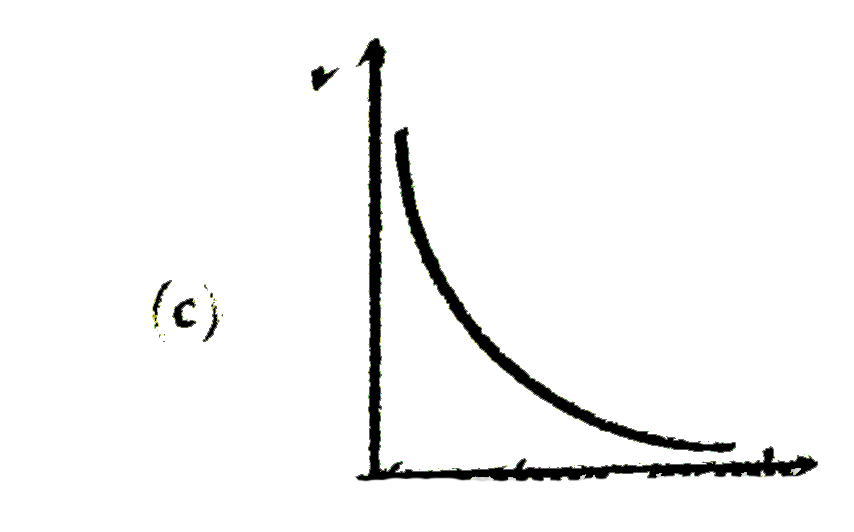What parameter can be determined from velocity-time graph of uniform motion?
To determine the parameter from the velocity-time graph of uniform motion, we can follow these steps:
1. Understand the Definition of Velocity:
- Velocity is defined as the rate of change of displacement with respect to time. Mathematically, it is expressed as:
v=dsdt
- Here, v is velocity, ds is the change in displacement, and dt is the change in time.
Hint: Recall that velocity is a vector quantity that indicates both speed and direction.
2. Relate Displacement to Velocity:
- Rearranging the equation gives us:
ds=v⋅dt
- This equation indicates that the change in displacement (ds) can be calculated by multiplying velocity (v) by the change in time (dt).
Hint: Think about how the area under a curve can represent a quantity in physics.
3. Integrate to Find Total Displacement:
- To find the total displacement over a period of time, we integrate both sides:
s=∫vdt
- This integral represents the total displacement, which is the area under the velocity-time graph.
Hint: Remember that integration can be visualized as finding the area under a curve.
4. Interpret the Velocity-Time Graph:
- In the case of uniform motion, the velocity remains constant. Therefore, the velocity-time graph is a horizontal line.
- The area under this horizontal line (which represents the velocity) over a specific time interval gives the total displacement.
Hint: Consider how the shape of the graph (a rectangle in this case) can help you calculate the area.
5. Calculate Displacement from the Graph:
- If the velocity is constant (let's say v) and the time interval is t, the area (displacement) can be calculated as:
Displacement=Velocity×Time=v⋅t
Hint: Use the formula for the area of a rectangle (Area = base × height) to find displacement.
Conclusion:
From the velocity-time graph of uniform motion, we can determine the parameter of displacement. The displacement is represented by the area under the velocity-time graph.
- Velocity is defined as the rate of change of displacement with respect to time. Mathematically, it is expressed as:
v=dsdt
- Here, v is velocity, ds is the change in displacement, and dt is the change in time.
- Rearranging the equation gives us:
ds=v⋅dt
- This equation indicates that the change in displacement (ds) can be calculated by multiplying velocity (v) by the change in time (dt).
- To find the total displacement over a period of time, we integrate both sides:
s=∫vdt
- This integral represents the total displacement, which is the area under the velocity-time graph.
- In the case of uniform motion, the velocity remains constant. Therefore, the velocity-time graph is a horizontal line.
- The area under this horizontal line (which represents the velocity) over a specific time interval gives the total displacement.
- If the velocity is constant (let's say v) and the time interval is t, the area (displacement) can be calculated as:
Displacement=Velocity×Time=v⋅t
From the velocity-time graph of uniform motion, we can determine the parameter of displacement. The displacement is represented by the area under the velocity-time graph.
Topper's Solved these Questions
- MOTION IN A STRAIGHT LINE BOOK - MODERN PUBLICATIONCHAPTER - MOTION IN A STRAIGHT LINE EXERCISE - REVISION EXERCISE (FILL IN THE BLANKS)
10 Videos
- MOTION IN A STRAIGHT LINE BOOK - MODERN PUBLICATIONCHAPTER - MOTION IN A STRAIGHT LINE EXERCISE - REVISION EXERCISE (SHORT ANSWER QUESTIONS)
19 Videos
- MOTION IN A STRAIGHT LINE BOOK - MODERN PUBLICATIONCHAPTER - MOTION IN A STRAIGHT LINE EXERCISE - HIGHER ORDER THINKING SKILL AND ADVANCED LEVEL QUESTION WITH ANSWER
5 Videos
- MOTION IN A PLANE BOOK - MODERN PUBLICATIONCHAPTER - MOTION IN A PLANE EXERCISE - Chapter Practice Test
15 Videos
- OSCILLATIONS BOOK - MODERN PUBLICATIONCHAPTER - OSCILLATIONS EXERCISE - Practice Test (For Board Examination)
12 Videos
Similar Questions
Knowledge Check
The slope of velocity-time graph for uniform motion of an object is
AUnityBZeroCInfiniteDMore than unity but has some finite valueWhich of the following velocity-time graphs (v−tgraph) represent uniform motion
A B
B C
C D
D
The velocity -time graph for a body with non-uniform motion is a
Astraight lineBstraight line parallel to x-axisCstraight line parallel to y-axisDcurved line
What can be deduced from the slope of a position-time graph of uniform motion?
View SolutionWrite some uses of velocity-time graph of an object in uniform motion.
View SolutionDraw velocity – time graph of uniformly accelerated motion in one dimension. From the velocity – time graph of uniform accelerated motion, deduce the equations of motion in distance and time.
View SolutionDraw position vs time graph of uniform velocity.
View SolutionWhat is the significance of a positive and b negative slope in velocity-time graph of an object in uniformly acclerated motion?
View Solution
